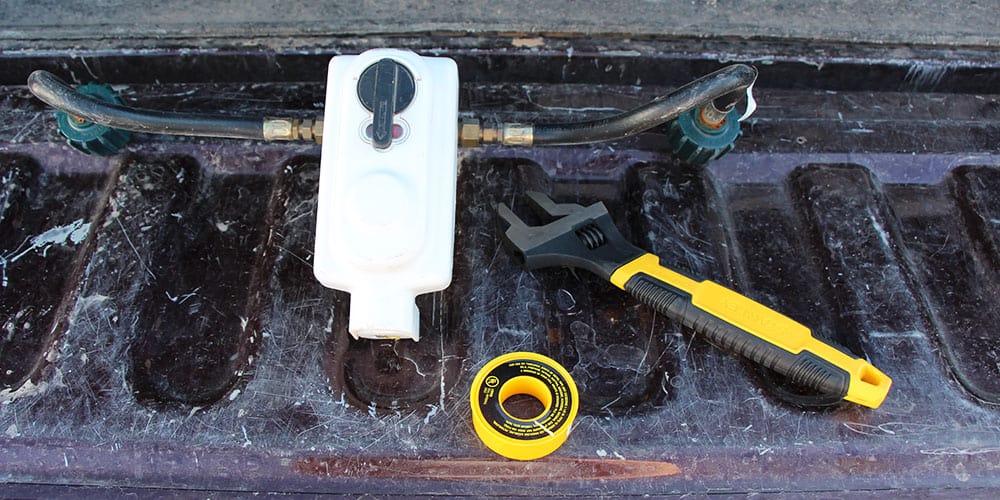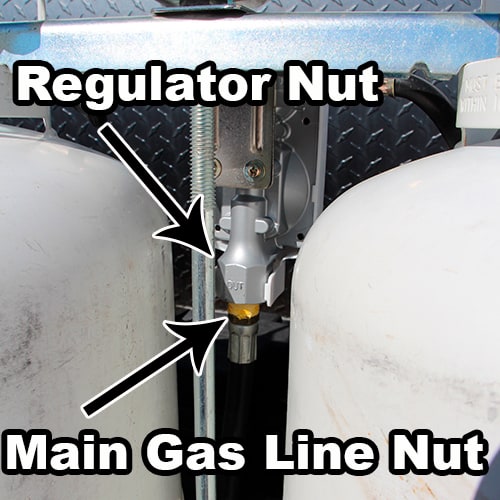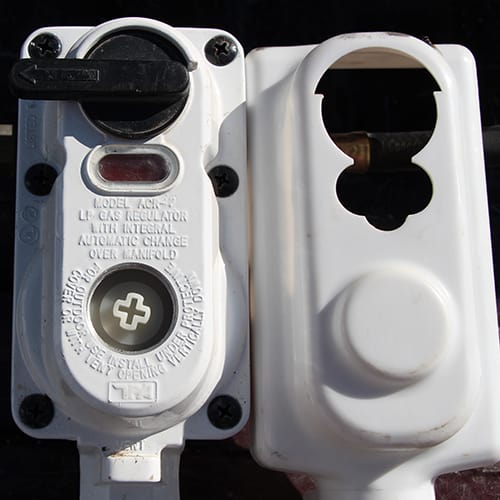Where is the RV Propane Regulator?
The propane regulator is the heart of every RV gas system. It makes sure you have the right amount of pressure to run your fridge, furnace, water heater, and your stove.
On a travel trailer and some RVs with dual propane tanks, the regulator is the box that has the two pipes coming out of the sides and connecting to each tank.
Related Product: Did you know RV Propane Detectors (click to view on Amazon) need to be replaced every 5-10 years? Make sure yours is still up to date before your next camping trip.
On travel trailers, the tanks are in front near the hitch. On RVs and some 5th-wheels, the tanks are normally in a side compartment near the front.
Some RV and 5th-wheel propane systems have 1 propane tank on each side or have a single large propane tank. These will use a standard propane regulator and not a dual one.
My travel trailer uses a dual 2-stage automatic RV propane regulator. If you are changing your single tank regulator, the process is basically the same.
See Also: 7 Signs That Your RV Propane Regulator Has Gone Bad

What You Will Need To Change A Dual RV Propane Regulator
Parts Summary (Links to Amazon)
- Flame King 2-Stage Propane Gas Regulator (or the regulator of your choice)
- Gas line pipe thread tape
- Crescent Wrenches (Need to fit 1 1/4 and 11/16 inch sizes)
- Leak Tester – could be a TopTes Gas Leak Detector or soapy water spray.
See Also: Propane Tank Recertification: How & Where To Get Recertified
You need a replacement regulator that is the proper size and style for an RV.
Normally they are pre-adjusted for the correct RV gas line pressure and have a bracket already installed to hang the regulator between the propane tanks.
For reviews and information on the best RV propane regulators, check out this article here.
The pigtails (lines that attach directly to the propane tanks) on my regulator were rusted and needed to be replaced as well, so I bought a replacement RV propane regulator that had pigtails already on it.
If you are only replacing the regulator, you will need to remove the pigtails from the old one and put them on the new one. You can do this after step 1 during step 2.
I replaced my old dual RV propane regulator with the Flame King 2-Stage Auto Changeover LP Propane Gas Regulator (click to view on Amazon) which is the same brand as the old one.
I needed to replace the old one because the automatic switch-over function wasn’t working and it wasn’t able to hold the right gas pressure for my furnace.
See Also: How Does An RV Propane Regulator Work?
The second thing you will need is gas line pipe thread tape (click here to view on Amazon).
This differs from plumber’s tape and made specifically for gas lines, including propane. It’s yellow and you can find it in any hardware store or online.
The last thing you will need is two adjustable crescent wrenches.
If you only have fixed wrenches, the nut on the replacement regulator was 1 1/4 inches and the gas line was 11/16 of an inch.
This may not be the same on the model of propane regulator you buy. Using an adjustable crescent wrench is going to be the easiest way to go. All the gas lines should be a standard RV size.
How To Replace A Dual RV Propane Regulator
Step 1: Turn Off Your Propane Tanks & Empty Gas Lines
The first thing you need to do is turn off your propane tanks and unhook them from the old regulator you are going to be replacing.
Next, go inside your RV or travel trailer and light one burner on the stove. This will empty the LP gas in the line so you won’t have any coming out when you remove the regulator.
Wait until the flame is no longer burning. Then turn off the gas on the stove so it doesn’t start leaking out when you turn the gas back on.
Step 2: Remove The RV Propane Regulator
The propane regulator is attached to the main gas line at the bottom.
To remove it, place a wrench on the nut of the main gas line and twist the regulator. Do not twist the main gas line, it is not made to move.
If you are having trouble twisting the propane regulator by hand, you can use another wrench on the lower portion which has normally has a hexagonal shape for a wrench to be used if necessary.

Some RV propane regulators like mine come with a plastic rain cover over the front part. You will need to remove this to access the nut on the bottom of the regulator so you can use a wrench.
RV Life Hack: How To Check How Much Propane You Have Left
The cover is easy to remove and you just need to pull it off by hand. Make sure the black switch is pointing down so it’s out of the way when you remove the cover.

Once you remove the RV propane regulator, you can also remove the pigtails if you are planning on using those.
My new RV propane regulator came with pigtails pre-attached, so I didn’t need to remove the old ones.
Use gas line thread tape when attaching the old pigtails to your new RV propane regulator to prevent any leaks.
Step 3: The Gas Line Thread Tape
Now you need to remove all the old yellow gas line tape from the main gas lines threads and tape it with the new stuff.
Make sure you tape the same direction you screw on the propane regulator so it doesn’t move and get undone while you tighten the regulator.
Step 4: Attach the RV Propane Regulator to the Main Gas Line
Now all you need to do is screw the new RV propane regulator onto the main gas line.
Use plenty of tape for a good seal and don’t cross-thread the nut onto the bolt. To tighten, use the two crescent wrenches for a snug leak-free fit.
Step 5: Attach Regulator to Propane Tanks
Once the RV propane regulator is connected to the main gas line all, you need to do is attach the two pigtails to your propane tanks just like you normally would.
If the regulator has a propane level monitor, it should flip from red to clear when you open a propane tank and point the arrow towards the open tank.
Step 6: Check for Leaks
Now that you have propane gas running through the regulator, you need to check the connection between the propane regulator and the main gas line for leaks.
You can do this by mixing water with dish soap and either spraying or dumping it on the connection.
There is also a pre-made gas line leak checker available (click to view on Amazon).
If no bubbles appear, you have a tight connection. If bubbles are forming there is a small leak, you may need to repeat all the steps and use more gas line thread tape.
We like to use our portable gas leak detector. It’s accurate, easy to use, and doesn’t make a mess. You can see the review for the one we use here.
Congratulations! If there are no leaks, you have successfully replaced the old dual RV propane regulator with a new one.
See Also: Best Small Portable Propane Heater For Indoor & RV Use
Frequently Asked Questions About RV Propane Regulators
What is a dual RV propane regulator, and how does it differ from a single regulator?
A dual RV propane regulator is a device that regulates the flow of propane gas from the propane tank or tanks to an RV’s propane appliances.
It differs from a single regulator in that it can connect to two propane tanks simultaneously. When one tank runs out of fuel, the dual tank propane regulator will automatically switch to the second tank.
What are the benefits of using a dual RV propane regulator?
Using a dual RV propane regulator increases propane storage capacity, improves propane flow consistency, and automatically switches between propane tanks without interruption.
Can a dual RV propane regulator run different propane appliances simultaneously?
Yes, a dual RV propane regulator can typically supply propane to multiple appliances simultaneously, such as stoves, ovens, water heaters, and furnaces, as long as the total propane demand does not exceed the regulator’s capacity.
Keep this in mind when looking for a replacement RV propane regulator. You should try to match the BTU rating of the original regulator.
If that’s not possible, it’s better to go a little bigger to make sure all the propane appliances in the RV will get enough fuel.
How does weather and temperature affect the performance of a dual RV propane regulator?
Harsh weather and extreme cold or heat can affect the performance of a low quality or old RV propane regulator.
Cold temperatures may cause propane to vaporize more slowly and drop the gas pressure in the lines.
High temperatures can increase pressure in the propane system.
Quality propane regulators are designed to withstand such conditions without compromising performance. But they can be affected more by temperature changes as they age.
Which is why you should replace the propane regulator if it’s over 10 years old or showing signs that it’s giving out.
Can a dual RV propane regulator be used with different sizes of propane tanks?
Yes, dual RV propane regulators are typically compatible with propane tanks of varying sizes.
If they have the right fittings and connectors to ensure a secure and leak-free connection.
Are there any maintenance tips to prolong the lifespan of a dual RV propane regulator?
Regular inspection and cleaning of the regulator, as well as ensuring proper ventilation around the regulator and propane tanks, can help prolong its lifespan.
Checking for signs of corrosion or damage before every camping trip is a good way to know when the regulator will need to be replaced.
You don’t want be cooking dinner while you’re camping and suddenly lose propane.
How to troubleshoot common issues with dual RV propane regulators?
Common issues with dual RV propane regulators are uneven propane flow, leaking fittings, or pressure fluctuations.
Troubleshoot the regulator by checking for loose connections, inspecting hoses for damage, and ensuring proper propane tank valve operation.
If the propane pressure in your RV still doesn’t seem right, it might be time for a replacement.
Have questions about RV propane regulators and how to install them? Leave a comment below.


Yes
I’m getting ready to instal my new propane regulator. ( 2 stage automatic)
Problem was , when I open either one of the cylinders, the valve on the bottom of regulator is leaking and you can smell propane
I tried to do the test, (recommended by a technician) before he comes to do repairs in case the regulator was stuck
Didn’t work. Valve is still leaking
Furnace and the stove work normal, but I have to keep turning off the cylinders because I don’t dare to use the appliances
Would you say , it is a regulator problem?
I do have a new one and I’m asking for your opinion
Thank you
It sounds like the diaphragm in your regulator has been damaged in some way. This is a very common issue and the only way to fix it is to replace the regulator with a new one. You are doing the right thing by replacing it in my opinion.
Noticed my furnace not heating properly but operating. In checking propane tanks, regulator tattle shows red. Checked tank & not empty. Switched to other full tank, tattle still red. Will not turn green but stove burners work & refridge works even with a red tattle.
regulator is 15 years old.
Suspect flow is enough stove & refrige but not enough proper flow for furnance. should I change regulator?
RV furnaces can be tricky, we’ve had lots of problems with our own. Replacing your 15 year old propane regulator is a good idea but you may want to also try removing the cap that covers the furnace exhaust pipe on the outside of your RV. Then run the furnace again to see if it helped. I know it sounds simple but airflow is key with RV furnaces and allowing more air to get out of the exhaust sometimes helps it burn hotter.
I have replaced regulator with new one and it will not switch from red when I open the valve on the propane tank it is pointing at. I switch to other tank and open vale and nothing. I thought maybe I had bought a dude so I ordered another one, same kind and still nothing. Is it possible to get two dude regulators or is something else wrong?
Hi Sherrill,
One thing that might be happening is there is still propane in your camper’s gas lines. It might be making it so no gas flows through the regulator when you open the propane tank and so it’s not recognizing that there is propane.
Try opening the propane tank again but do it slowly so the shut off valve on the tank doesn’t accidentally engage. Then go inside the camper and light one of the burners on the stove to get propane flowing from the propane tank to the regulator.
If you can hear propane gas hissing through the regulator that should mean it’s working. Hopefully, the indicator will be clear or showing green at this point. If you can’t hear gas going through the regulator even with a burner lit and the propane tank open you might have a problem with the connection between the regulator and the tank.
I hope this helped. Let me know if you have any more questions.
So, no gas flow, to stove, water heater, with five years old dual regulator “always indicating green”, even when propane tanks are removed?? No apparent gas leaks noted either….
It sounds like the propane regulator might be bad. I’ve heard of them always showing red even when connected to a full propane tank but never green even when not connected. Sounds like you may need to change it.
I have a dual fuel 10k watt generator with a built in propane regulator, can I use the Flame king auto change over unit without removing the generator regulator or will the pressure be reduced too much?
Hi Thomas,
You can connect your propane generator to your RV but there are a few things you have to add to make it work correctly.
Here’s a link to a forum where an RVer has written detailed instructions on how to connect things correctly. Hope it helps.
I just need to replace a hose from reg to a tank. Broke the green connector. I have a short hose that has another regulator on it. Will it work until I get another or will it change pressure too much??
Hi Dennis,
That’s a tough question to answer without knowing what kind of regulator is on the new hose. But if it’s just a temporary replacement it should be ok. You might notice it more when using high BTU appliances in your RV but it should work for a few days.
Hello I have a permanently mounted propane tank underside of my rv. Dometec refrig started not working on propane. I changed both regulators, and it seemed to help. Now, not lighting again. Hot water heater is now acting up and not lighting. I bled line, it started, but when time to kick back on, it doesn’t
Third thing I noticed is that the electrical switch to the gas valve on the propane tank doesn’t seem to shut the valve anymore. The valve stays open. Any suggestions?
Thanks
Lee
Hi Lee,
Is your stove working fine?
If the fridge and water heater are not lighting but the stove is working, I would clean the burner assemblies on both of them to make sure there’s nothing blocking them.
Some oil may have gotten into the lines from contaminated propane and it might be in clogging things up.
The electric switch not working could be a problem with the power line running between it and the battery. There’s often an inline fuse near that battery you should check.
There might be a second electric shut off on your propane tank that’s connected to the LP detector. If there are any issues with the wiring to the detector it could be causing the valve to shut off randomly.
If I have one propane cylinder on should propane come out of the other bottle connection?
Hi Kevin,
The connection with no cylinder attached should register as empty and stay closed. Also, if you make sure the dial is facing the side the tank is on, you shouldn’t have any issues.